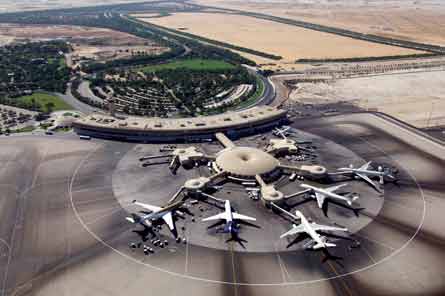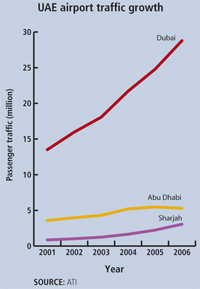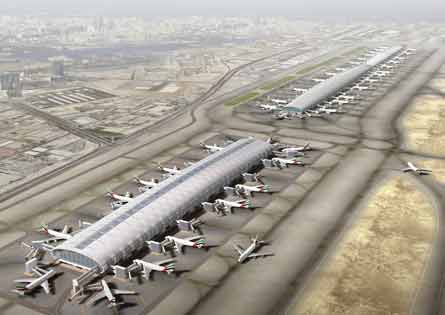In the United Arab Emirates, four airports within a 150km radius are spending nearly $50 billion to build terminals able to handle over 200 million extra passengers per year. How realistic are their ambitions?
Construction cranes dot the landscape from the Sheikh Zayed Road, a busy 10-lane highway that connects Abu Dhabi and Dubai. The two bustling cities seem to blend together these days to form one mega construction site. But the concentration of cranes particularly intensifies at Jebel Ali near the Abu Dhabi-Dubai border, where contractors are working frantically to turn a 140km2 site into an airport city known as Dubai World Central. A new international airport capable of handling 120 million passengers annually will be the centrepiece of Dubai World Central, which will also include logistics, commercial and residential zones as well as an enterprise park and golf resort.
Just 40km down Sheikh Zayed from Jebel Ali is Dubai International Airport. There construction crews are also working frantically to squeeze new passenger and cargo terminals as well as a new headquarters for Emirates into a 14km2 site surrounded by downtown Dubai. The project will triple Dubai International’s capacity from 25 million to 75 million passengers by 2010. Last year the airport handled 28.8 million passengers, making it the world’s 37th largest.

At the opposite end of Sheikh Zayed, about 80km from Jebel Ali and 30km from downtown Abu Dhabi, Abu Dhabi International Airport will be able to handle 50 million passengers after a new mid-field terminal, which will open in phases from 2010, is completed. As an interim solution, a third terminal at the existing south-field site will open next year, lifting Abu Dhabi’s passenger capacity from seven million to 12 million. Last year the airport handled 5.3 million passengers.
About 15km in the other direction from Dubai International sits yet another major airport, Sharjah International. Last year the airport, which in April completed an expansion project that lifted capacity to eight million, handled 3.1 million passengers.
“Despite all the competition, all the airports in the UAE are growing and all the airports in the Gulf are growing,” says Sharjah Airport Authority director general Ghanem Al Hajri. “Competition is very healthy. It’s all in the interest of the consumers.” The idea that airports in a country with a population of five million will be able to handle in a decade over 250 million passengers, outstripping by more than 50 million what London’s five major airports combined are now planning to handle, seems crazy. But factor in projected double-digit GDP growth, the UAE’s natural position for attracting transfer traffic, and the tourism ambitions of its two major cities, and the 250 million goal does not seem so far-fetched. “It may sound optimistic,” says Abu Dhabi Airport operations manager Ibrahim Mansoor. “I can’t speak for everyone in the country but there is a lot of initiative to create big hubs here.”
The idea that airports in a country with a population of five million will be able to handle in a decade over 250 million passengers, outstripping by more than 50 million what London’s five major airports combined are now planning to handle, seems crazy. But factor in projected double-digit GDP growth, the UAE’s natural position for attracting transfer traffic, and the tourism ambitions of its two major cities, and the 250 million goal does not seem so far-fetched. “It may sound optimistic,” says Abu Dhabi Airport operations manager Ibrahim Mansoor. “I can’t speak for everyone in the country but there is a lot of initiative to create big hubs here.”
Dubai Aerospace Enterprise (DAE) Airports chief executive Kjeld Binger points out airports in the region need to grow fast just to keep up with soaring demand for air travel: “Expansion is badly needed. Growth has completely outmatched supply.”
Fly into Dubai and it is obvious expansion is well overdue. “If you come to Dubai at night the concourse is like a fish market. It’s so busy,” says Ahmed Khoory, senior vice-president Dubai airport development at Emirates.
He adds 8,000 passengers per hour now pass through the airport’s only concourse during peak periods, although the capacity is only 6,000. Emirates at the beginning of this year was forced to increase the minimum connection time from 45 to 75 minutes because it was having to park too many aircraft at remote stands. The existing concourse now only has 19 widebody gates but Emirates, which accounts for about 60% of Dubai’s traffic and only operates widebodies, has 45 departures in its largest bank. “The beauty of Dubai is it connects east and west. We have 45 minutes connecting time as standard but you can’t have that without contact stands,” Khoory says. “[The lack of gates] is affecting everything – the commercial business and operationally.”
A second concourse will open in the first quarter of next year, providing another 27 gates and increasing hourly capacity to 9,000. But with Emirates growing at a 20% annual clip, the new facilities cannot be completed fast enough. Khoory says the 9,000 figure will be exceeded before 2010, when a third concourse opens, providing another 20 gates.
When both new concourses are finally operational, Dubai International will be able to handle 75 million passengers annually, including 20 million in the existing concourse and about five million in Terminal 2, a simple gateless facility used mainly by Indian and Iranian carriers. But the airport expects to reach 60 million passengers in 2010 and is on track to reach 75 million about three years later.
There is no space for a fourth concourse and Dubai has already become the world’s first airport to expand by building underground. A new underground terminal dedicated for Emirates will open next year – at the same time as the second concourse opens. Passengers will enter the airport, check-in and clear immigration underground before taking lifts to the concourses. “In terms of logistics it’s better for passengers. Instead of walking one kilometre, you go up in an elevator to the departures area,” Khoory says.
Dubai’s premium service
For the third concourse, premium passengers proceed directly to the exclusive second level, where there will be lounges and bridges connecting to the upper deck of Airbus A380s. “There’s not a terminal in the world like this,” boasts Dubai Airports Company general manager business development Rimzie Ismail. She adds that 18 of the 20 gates in the concourse will be A380 capable. Emirates, which has 47 A380s on order, will use all of them plus five A380-capable gates in concourse two.
The second concourse will not be as lavish but Khoory says it will still have “massive lounge facilities” and a five-star hotel. He adds the underground terminal will also have special handling for premium passengers, including a curb-side concierge service, VIP check-in counters and separate immigration.

Both new concourses will be dedicated to Emirates, which will also open later this year a new headquarters building that will be connected to the new terminal via a tunnel. Khoory says Emirates will need to continue using 15 of the 19 widebody gates in the existing concourse, giving it a total of 62 gates, because its largest bank next year will already be at 57 departures. That will leave just five widebody and eight narrowbody gates for other carriers.
“With the way Emirates is going we’ll have to use Concourse 1. I’m sure it will be difficult with authorities and other airlines but it has to be that way – Emirates is the national airline,” Khoory says.
As Dubai International will not be able to keep up with soaring demand, the government believes it must begin to invest in a new $33 billion airport even before the $4.5 billion in improvements to the existing airport are completed. “The vision of Jebel Ali is with a much bigger plan in mind – to make Dubai the largest global hub in the world and to make it the world’s centre for aviation,” says Ismail.
The world’s largest airport
Dubai projects the airport will handle 100 million passengers in 2020, making it the world’s largest international airport, surpassing an estimated 90 million passengers at London Heathrow. Ismail says the first phase will open in the first quarter of 2009, with one runway and one passenger terminal capable of handling five million passengers annually. Discussions with potential airline customers will begin later this year and point-to-point passenger carriers and dedicated cargo operators will likely be the first to move. Ismail says pricing has not yet been established and the airport will be developed in phases subject to airline demand. “We don’t want to put the cart before the horse,” she says. “In Dubai we take things as they go.”
So far only Kuwait-based budget carrier Jazeera Airways has come out and said it wants to be one of the initial users. “Jebel Ali will be a wonderful airport. We’re looking forward to Jebel Ali and we want to be one of the first airlines there,” says Jazeera chief executive Marwan Boodai.
But Boodai expects the initial terminal will not open until the second quarter of 2009 because it will take extra time for the roads and parking lots to be completed. “It won’t be more expensive than the existing airport. To attract new carriers I expect there will be some reduction,” he says.
When it is completed, Dubai World Central will have six parallel 4.5km long runways and three passenger terminals, including one dedicated for Emirates. The carrier will clearly run out of room at the existing airport and its president, Tim Clark, has indicated that it will move in one swoop when Dubai World Central is large enough to accommodate its entire operation. But it is unclear when that will occur. “Jebel Ali will be the world’s biggest airport and the design is fantastic, but for us to move or stay it’s basically a government decision,” says Khoory. “Because Terminal 3 hasn’t opened yet, to think of moving to Jebel Ali is too early.”
For at least the next several years Dubai is planning on having two airports. A dedicated 40km light rail link will connect them in 20 minutes and a separate train will serve both airports along with 30 other stops along Sheikh Zayed Road.
“You won’t see Dubai World take over on this side of 2020. You need to give it time to get the right design,” says Binger of DAE, which expects to have a role in developing and designing Dubai World.
There is no doubt Dubai World will happen – it is an integral part of the Dubai government’s future vision for the city. Not only does Dubai want to create the world’s largest hub, it seeks to create an aerospace centre which will rival Singapore, with maintenance, manufacturing and other services provided by DAE and a wide mix of foreign companies. It also sees a new state-of-the-art airport as essential to meet its lofty tourism goals. The number of visitors to Dubai is projected to grow to 15 million in 2010 from six million last year and only two million in 2002.
“The location is here. The development is here. The government of Dubai is determined to do this and it will,” Binger says. “Only fantasy can limit what can be done here.” Adds Khoory: “When it comes it will be really fantastic. The ruler of Dubai wants everything to be number one. This will be number one. It will be the biggest in the world.”
The Abu Dhabi government has an equally ambitious vision for its city with several grandiose projects designed to make it a leading top-end tourist destination, including a $3 billion hotel, a Formula One car racing track and local branches of the Louvre and Guggenheim museums. Abu Dhabi also sees its airport becoming a major hub for the world, but it is not as bold when it comes to airport planning. “We don’t want to overbuild. We want to build to forecast,” Mansoor says. “We want something that is reasonable and can be achieved. We don’t want to do what Dubai does. We want to be realistic.”
Abu Dhabi will open a third terminal in March 2008, providing eight additional gates and raising annual capacity from seven million to 12 million passengers. A second runway is slated to open at the same time.
The airport is actually operating under capacity now and its traffic decreased slightly last year due to a 69% capacity reduction by Gulf Air, which began pulling back its Abu Dhabi hub in 2005 and has since gradually reduced its weekly departures from 239 to 32. But Etihad, which now operates 228 weekly departures from Abu Dhabi’s Terminal 1, has added flights almost as quickly as Gulf Air has pulled back. The airport now must expand quickly to keep up with more rapid growth at Etihad, which will add another 50% capacity this year. As a result, Abu Dhabi’s overall traffic should reach seven million in 2007.
Etihad says Terminal 3, which will be dedicated for its use, will make connections easier and may allow it to decrease minimum connection times below the current one hour. “They are developing a very good airport for the national carrier,” says Etihad executive vice-president finance James Rigney. “We’re working very closely with the airport.”
Mansoor says that while Terminal 3 will be “a very good facility”, it is only an interim solution until the midfield terminal opens in 2010. The midfield terminal is designed to handle up to 40 million passengers annually but Mansoor says it will likely open with a capacity of 12.5 million. The terminal has a modular design, allowing for a phased opening and construction to continue without impacting the operation.
Etihad, which now accounts for 60% to 70% of the airport’s traffic, will move its entire operation in one go. Mansoor acknowledges the terminal may not match Dubai’s level of service for premium passengers. He says the new terminal will have dedicated check-in and immigration for premium passengers but Abu Dhabi has not decided if it will build dedicated airbridges to connect lounges with the upper deck of Etihad’s A380s. “We are in discussions with Etihad and they’ve requested that. We want to offer something like Dubai for premium passengers to help Etihad attract premium passengers. We’ll look at that but there are costs for doing that.”
The design, which aims to keep passenger walking times at a minimum, will be frozen later this year and construction will begin in 2008. “It is very futuristic. We want it to be expandable and provide the best passenger service in terms of ambience and passenger convenience,” Mansoor says.
Sharjah thinks it is a step ahead of its competitors when it comes to capacity planning. In April it completed an expansion project which increased the annual capacity of its only passenger terminal from three million to eight million. “We believe we’re in good shape because the development has already taken place,” says Al Hajri, adding Sharjah began planning the project after it established Air Arabia in 2003. The budget carrier now accounts for two-thirds of the airport’s traffic.
Sharjah is now focusing on an apron expansion which will add 12 more passenger aircraft parking spots early next year. “This is essential because now we’re turning business down in peak times. We don’t have the space,” says Al Hajri.
The recently completed terminal expansion project did not include more gates or parking spots but added a new arrivals area with four large luggage carrousels and a new departures area with 40 check-in counters. The terminal previously had only 24 check-in counters and two small luggage carrousels.
The airport’s 2015 master plan envisions the construction of another eight airbridges, which will not increase capacity but will improve customer convenience. Remote parking spots are now used during peak hours because the current terminal only has six airbridges with a seventh under construction. But Air Arabia chief executive Adel Ali points out that having fewer airbridges keeps costs down and makes it easier to turn around aircraft. “We have the space we need. I don’t want a major international airport because that adds cost. Sharjah offers us a green field and a fantastic turn-around airfield,” Ali says. “If we go to 100 aircraft Sharjah will be ready.”
Catering for low-cost carriers
While Abu Dhabi and Dubai focus largely on widebody network carrier traffic, Sharjah and Dubai World Central will likely compete for low-cost carrier business. There are currently only two budget carriers serving the UAE but the sector will see significant growth as bilateral restrictions ease. “It will only grow,” Ismail says. “You may see easyJet and Ryanair in a few years at Jebel Ali. They already fly to eastern Europe.”
She adds that Dubai International’s Terminal 2 is already “tailored for a low-cost operation” because it is 10% to 15% cheaper than Terminal 1 and has no airbridges. Boodai says Jazeera, which now operates seven routes from both terminals, plans to serve 20 destinations from Dubai within two years and “most likely we’ll be operating at both airports”. He adds Dubai International will be used for those heading to downtown Dubai while Jebel Ali is closer to tourist destinations and many of the city’s new residential and commercial developments.
Sharjah and Dubai World Central are keen to attract budget carriers, including new long-haul operators, but neither plan to build dedicated low-cost terminals. “We don’t want to do that,” Al Hajri says. “We want to serve passengers well. We are able to keep our costs down. That’s what counts.”
Ismail agrees: “At the moment we don’t have a plan for a low-cost terminal. This is the difference between Dubai and the rest of the world. To get a low-cost carrier you don’t need to give cheap infrastructure and it doesn’t mean you have to downgrade the airport. That reflects badly on the country.”
Source: Airline Business























